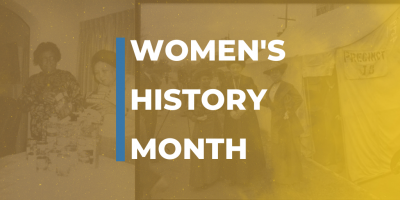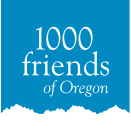Join us as we celebrate Women's History Month in Oregon.

Across the United States, the month of March is celebrated as Women’s History Month, a time to explore and elevate the stories of women whose lives have made a difference in myriad ways. Here in Oregon, there is no shortage of such stories. You can read about dozens of the extraordinary women who have helped shape our state here and here.
At 1000 Friends, we think it’s particularly important to honor the incredible women who have created and maintained Oregon’s unique land use planning program over the last 50 years. Here are just a handful of the women whose contributions stand out.
Senators Hector Macpherson and Ted Hallock and Governor Tom McCall are often cited as the originators of Oregon’s land use planning system, but several women deserve similar recognition. Nancie Fadeley, for instance, is a name every supporter of 1000 Friends of Oregon and Senate Bill 100 should know. Representative Fadeley was Chair of the House Committee on Land Use and the Environment and played the pivotal role on the ground as the legislation was being debated, ultimately seeing the bill through to passage.
As House Counsel for the Oregon House Committee on Land Use and the Environment in 1973, Janet McLennan was with Nancie every step of the way. Without these two women organizing bipartisan legislative support for Senate Bill 100, Oregon may very well have gone the way of its sprawl-happy neighboring states. Also worth noting?
Every one of the 11 women who were part of the Oregon Legislature in 1973 voted in favor of SB 100.
We think Nancie and Janet might have had more than a little to do with that, too!
Another of those legislators was Norma Paulus, who was elected to the Oregon House of Representatives in 1970. She campaigned on “recycling and land use and environmental issues.” In an oral history, Norma tells the story of how the Speaker of the House established the Land Use and Environment Committee—the one chaired by Nancie Fadeley—with the express purpose of making it the first committee where the majority of its members were women. Not only was that the committee where SB 100 went and passed, but it was also the committee that stewarded major legislation claiming the rights of women. Norma worked, in particular, with Women for Agriculture to ensure SB 100 protected farmland. They also worked together to change inheritance laws that discriminated against farming women, and on Willamette River Greenway protections.
Once SB 100 had passed into law, the long-term work began: how to implement such a sweeping and visionary piece of legislation? Enter Maggie Collins. In creating Oregon’s land use planning program, the legislation also created the Land Conservation and Development Commission (LCDC), and it was LCDC that was tasked with developing what would become the 19 Goals of Oregon Land Use Planning. The first—and arguably the most important—of those goals requires public participation in land use planning processes, and Maggie Collins (who had already played a key role lobbying for passage of SB 100 on behalf of the Oregon Environmental Council) was an original member of the Citizen Involvement Advisory Committee that put Goal 1 in place. Maggie went on to serve as a planner and planning director for several Portland Metro area cities.
Another early and ongoing contributor to Oregon’s land use program is Anne Squier. Anne and Maggie teamed up to push for the concept of urban growth boundaries (UGBs), which became the heart of statewide land use planning Goal 14: Urbanization. Anne went on to be the Natural Resources Policy Advisor to Governor Barbara Roberts (more on her in a moment), to serve as a Commissioner on LCDC, and to chair the Columbia River Gorge Commission. In addition to her illustrious career touching on virtually all aspects of Oregon’s land use laws, Anne is also a “conductor” on the Harborton Frog Shuttle, a multi-agency project to protect one of Portland’s at-risk species.
Over the 50-year history of Oregon’s land use planning program and 1000 Friends of Oregon, there have been numerous attempts to overturn the legislation, many within the first two decades. It was during those tumultuous times that Barbara Roberts emerged as a champion of SB 100, first in the Oregon House, then as Secretary of State and then, finally, as Governor of Oregon—the first woman in Oregon history to be elected to that office, and a crucial supporter of Oregon’s land use planning system to this day.
In terms of 1000 Friends’ own history, many of our successes have been made possible by the talented women who have spent time as our staff and board members.
In addition to Nancie Fadeley, Janet McLennan, and Barbara Roberts—all of whom have served on our board over the years—here are just a few of the more recent women who have gone on from 1000 Friends to other notable Oregon land use planning positions: Lisa Bates (who served on our board and is now an Associate Professor at PSU in the Toulan School of Urban Studies and Planning and is Portland Professor in Innovative Housing Policy), Anyeley Hallova (who served on our board until she was appointed as a current LCDC Commissioner), Lynn Peterson (who served as our Transportation Specialist as well as our Interim Executive Director before being elected Metro President), and Pam Phan (who was our Housing Program Manager and co-creator of our Land Use Leadership Initiative before joining Design+Culture Lab and Community Alliance of Tenants).
Notably, our network of regional Affiliate Groups is also comprised of organizations largely led by women: Shelley Wetherell at Friends of Douglas County, Sarah Deumling at Friends of Polk County, Kathryn Jerndstedt at Friends of Yamhill County, Cameron LaFollette at the Oregon Coast Alliance, Cherry Amabisca at Save Helvetia, and Heather Staten at Thrive Hood River. Aileen Kaye at Friends of Marion County even hosts a monthly land use radio show called “Keeping Oregon, Oregon.”
Of course, any list of women essential to Oregon land use planning and 1000 Friends’ history would be incomplete without our Deputy Director Mary Kyle McCurdy, a one-woman powerhouse when it comes to Oregon’s land use policies.
After more than 30 years with 1000 Friends, Mary Kyle is perhaps the state’s most visible and well-recognized land use advocate. Certainly, she is the reason 1000 Friends is what it is today. Mary Kyle is also a role model and mentor for her colleagues and collaborators, including the 13 other women who are part of our current staff and board.
As we look to the future of land use planning in Oregon, we know that there, too, women—and especially, we hope, an increasing number of women of color—will play a crucial role. We are inspired by women like Lisa, Anyeley, and Pam, and by our own Nicole Johnson, who penned last month’s essay about what it means to be a Black woman in Oregon land use planning.
We encourage you to take time this month to click through these links and learn more about the wonderful women who have made Oregon’s land use program and 1000 Friends of Oregon such unique and powerful forces. The names we’ve mentioned here today are only a sampling; our list is by no means complete.
If there’s a woman you know who deserves special recognition in the world of Oregon land use planning, consider making a special gift in her name.
In the meantime, join us in honoring this extraordinary group of women for all they have done—and all that they continue to do—for Oregon!
